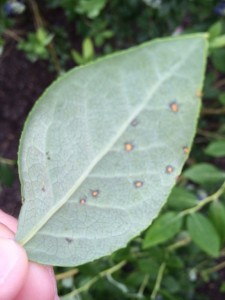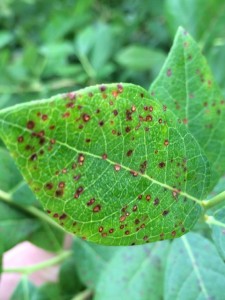Blueberry leaf rust is being found in fields across our area. I took these pictures this morning (April 28).
According to Dr. Phil Brannen, UGA Fruit Pathologist, this is likely as a result of the recent heavy rainfall we’ve received. It is a good time to start scouting for rust if you have not already done so. The blueberry IPM guide at www.smallfruits.org provides information on specific fungicides for rust management. If a variety is susceptible to rust, early defoliation can result, and this will reduce yields next year as a result. Scouting is required to determine whether rust is developing in specific varieties. Many fungicides applied for other leaf spots will also have rust activity; this is particularly true of the strobilurin (Abound, Pristine, etc.) and DMI fungicides (Proline, Quash, Tilt, Orbit, Indar, Bumper, etc.). For organic growers, Sonata is one of the few organic fungicides that lists rust on the label.
Post-season leaf spot management will still be important and a fungicide application should be considered to prevent premature defoliation due to rust, Septoria, and anthracnose leaf spots.
More info on leaf rust:
Leaf rust is usually of minor importance; however, epidemics have been reported on lowbush blueberry, where the disease contributes to the leaf spot complex. Occasionally, epidemics occur on highbush blueberry, especially in the states on the East Coast of the United States. The disease has been reported in Michigan and in the Pacific Northwest, but it is considered rare. In the lower southeastern states, Florida and Georgia for example, the disease can be particularly severe on some rabbiteye and southern highbush blueberry varieties. The disease is also taking on international importance, as it has now been reported in Argentina and Spain.
Symptoms
Small, chlorotic to yellow spots, which usually appear by midseason, are the first leaf symptom on blueberry. Spots on the upper surface of the leaf turn reddish brown and if the disease is severe, the entire leaf may eventually die as the spots coalesce and become necrotic. Underneath the spots, yellowish-orange uredinia develop conspicuously on the abaxial side of infected leaves. These pustules turn rusty red with age. Infected leaves usually drop prematurely. This disease, like other foliar diseases, can have a direct impact on yield due to early defoliation and reduction in return bloom in the following year.
Causal Organism
The pathogen Pucciniastrum vaccinii sensu lato is a heteroecious species complex of rust fungi that occur on many ericaceous hosts. There is a need for further taxonomic work, but Sato et al. divided P. vaccinii into two North American species, with Thekopsora minima P. & H. Sydow and Naohidemyces vaccinii (Alb. & Schwein) S. Sato, Katsuya & Y. Hiratsuka being suggested for the eastern and western North American species, respectively. The aecia of the eastern species are peridermioid (having a peridium that is tongue or blister-like and forms outside the host); those of the western species are uredinoid. Newer publications continue to use the P. vaccinii species designation, but species should be further clarified. For the purposes of this present review, we will continue with the P. vaccinii sensu lato approach to the broad species designation, with the realization that a minimum of two and possibly more species may be represented in this complex.
On blueberry, uredinia are hypophyllous and numerous and often grow in loose clumps in discolored spots. Urediniospores (16–24 12–19 m) are broadly obovate or ellipsoid, with yellowish orange contents (Fig. 4); they are borne on a short stalk and released through a central pore. The cells surrounding the pore are ovoid and smooth. Spore walls are 1–1.5 m thick, colorless, and slightly roughened or minutely echinulate.
Telia are also hypophyllous, and teliospores form within epidermal cells. Teliospores (7–10 14–17 m) are sessile and oblong to columnar and have two or more vertical cell walls; each cell probably has a single germ pore. Spore walls are lightly colored and uniformly thick. Basidia are external.
On hemlock (Tsuga sp.), the alternate host, spermagonia are hypophyllous, subcuticular, numerous, and inconspicuous. Circular aecia form on the lower side of current-season needles in yellow spots. They erupt from beneath the epidermis and form without a peridium, depending on the region in North America (as mentioned above). Aeciospores (18–24 15–21 m) are produced in chains and are globoid to broadly ellipsoid; they have a wall (1–1.5 m thick), which is finely and evenly roughened with flat or rounded warts (T. minima) or echinulate (N. vaccinii).
Disease Cycle and Epidemiology
P. vaccinii has a macrocyclic life cycle. In the spring, airborne aeciospores infect newly emerging blueberry leaves. Uredinia form about midsummer on the lower side of leaves. Urediniospores reinfect blueberry in a repeating secondary cycle, which leads to rapid inoculum buildup and disease spread. The latent period may be completed in only 10 days at 20 oC. The pathogen does not systemically invade blueberry. Telia form within the epidermal cells of infected leaves, which eventually drop to the ground. Basidia arise from germinating teliospores in dead leaves, and basidiospores infect young hemlock needles in the spring. Inconspicuous spermagonia develop on the lower side of needles, followed by yellow aecia.
Previously, leaf rust was thought to be more prevalent in areas within the native range of hemlock. However, recent reports from both Argentina and Spain note that hemlock is not available, and it is suspected that in regions with mild winters, uredinia may overwinter on the leaves of native evergreen Vaccinium spp. or on leaves which remain green, even through the winter. If so, this might account for the presence of the disease in areas, particularly in the south, that are also remote from hemlock. In Maine, the disease has been observed on lowbush blueberries as far as 0.4 km from hemlock. Infrequent outbreaks of the disease in the mid-Atlantic states may be caused by windborne urediniospores from the south.
Control
Numerous fungicides have significant activity against urediniospores of P. vaccinii, but not all of these are registered for use on blueberry. Among these, chlorothalonil, mancozeb, and copper sulfate provide fungicidal activity, while propiconazole and azoxystrobin provide fungistatic activity. Pyraclostrobin and fenbuconazole also have activity against rust which is presumed to be fungistatic. Historically, fungicides have been applied at petal fall and again 10–14 days later to control leaf rust on lowbush blueberry. For rabbiteye and southern highbush varieties, applications are recommended for late spring through summer for management in Georgia, but timing varies by geographic location, as evidenced by recommendations in Florida which include fungicide applications in the spring once leaves first form. In areas where leaves remain throughout the winter, epidemics are likely initiated earlier. Removal of all hemlocks from within a 0.4-km radius of blueberry fields, especially those upwind, may be beneficial. In areas with mild winters, it may also be beneficial to remove all evergreen Vaccinium spp. located near blueberry plantings, though this may be impractical in some locations.
Highbush blueberry cultivars vary in their susceptibility to leaf rust, as do rabbiteye and southern highbush. Sources of resistance exist within highbush blueberry and possibly within other Vaccinium spp. as well. Hybrids between V. uliginosum and highbush blueberry are generally susceptible.



